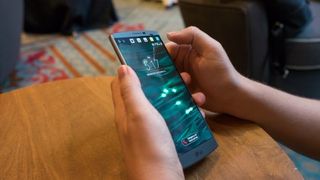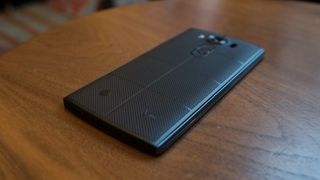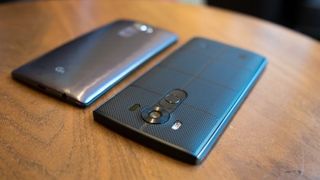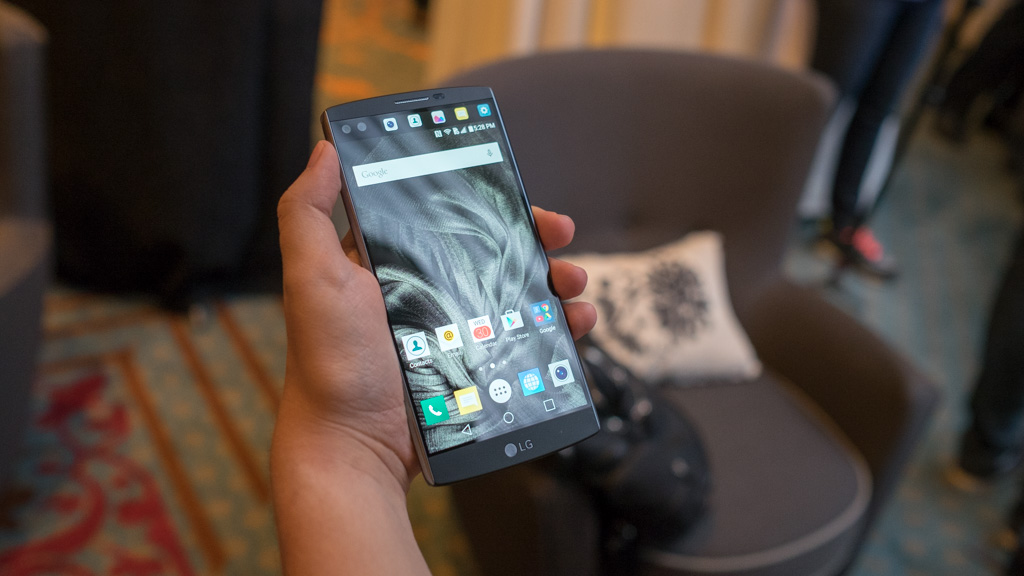TechRadar Verdict
The LG V10 is an intriguing phone, thanks to its sliver of a second screen at the top and dual front cameras for extra-wide selfies. It also has a removable battery, microSD slot and 4GB of RAM, but the software isn't refined and it's pricey.
Pros
- +
Novel second screen
- +
Wide selfie camera
- +
Extra durable design
Cons
- -
Just missed Android 6.0 Marshmallow
- -
More expensive than it should be
- -
Divisive ruggedized design
Why you can trust TechRadar
The LG V10 has me convinced that Dr. Ram-chan Woo and his design team really are a bunch of mad scientists determined to bend and shape unique smartphones. This is their latest and, by far, most Frankensteinian creation yet.
It's a bold mutation of the standard Android phone that I think looks like a three-eyed, two-headed monster thanks to its three cameras and second screen. My review handset is opal blue, but actually looks closer to pale green, which just further solidifies its ogre-like origins in my mind.
It's come to life in an effort to radically disrupt traditional features, and, good news, it's more than another, silly LG experiment. I found its two front-facing cameras, one with a wide selfie angle, to be exceptional for taking group shots and capturing the quintessential backgrounds, with everyone and everything in the photo.

The seemingly stunted, but handy 2.1-inch display at the top is a small notifications and shortcuts hub that keeps the main display clear of texts when you're watching a movie or browsing the web. This always-on panel can also dimly show the time or allow you to quickly adjust settings, even when the phone's main screen is off.
This feature, in part, makes it a misunderstood monster of a phone. While the LG V10 takes several cues from the flagship LG G4, the look and feel of this device is completely different. It's bigger, more rugged and has a little bit of extra power to it.
Just as freakishly large as its grip-expanding dimensions is the LG V10 price. In the US, it costs $700 without a contract through AT&T, or $250 with a two-year contract with Verizon. You won't find the LG V10 in the UK or Australia, but it'd likely cost as much as a top-priced phablet, like the Samsung Galaxy S6 Edge+ at £600.

This automatically makes Google's Nexus 6P and Moto X Style Pure Edition a safer choice for cheap phone buyers, and it puts the LG V10 in the same price league as the Samsung Galaxy Note 5 and iPhone 6S Plus.
But none of these best phone rivals have a wide selfie camera and second display, or and few have extras LG is quickly becoming known for, like a swappable battery and microSD card slot.
My time with this Android Lollipop 5.1.1 phone was further proof that, while LG isn't bending its latest phone, like it did with the LG G Flex 2, it's still determined to try bold, new ideas, while Samsung and Apple play it safe.
Design
LG V10 is durable, with an interesting mix of stainless steel sides and a silicone skin back. Its bumpy texture and rubbery feel really contrast with the LG G4, which has smooth leather and metallic-painted plastic style choices.

The benefit to this new concoction, dubbed Dura Guard and Dura Skin, is that it can survive drop tests like only a few other phones can. It's built to military-grade standards, which in my hands feels like there's a bulky, built-in case that I was going to (or really should, but never) buy.
Added to that already-tough formula is a much appreciated double-paned Gorilla Glass 4 for extra protection around front. That means it doesn't need to sport the same slight curve as LG's flagship device, and the LG V10 dimensions come out to a cumbersome 159.6 x 79.3 x 8.6mm and hefty weight of 192g.
The size and mix of metal, silicone and glass make it feel like a big phone, but it could be worse since there's lighter plastic here not. Its mainly limited top the top to expose the micro USB port, headphone jack and speaker. LG's rear-facing volume rocker flanks the fingerprint sensor power button in plastic, too, and while you can't see it at first, the underside of the silicone cover is really plastic if you peel it back to expose the removeable battery and microSD card slot.

Though the LG G4 is actually a bit thicker at its curved apex, everything else about this new phone is bigger, with the clear intention to challenge the iPhone 6S Plus, Samsung Galaxy Note 5 and other phones threatening to rip your pockets.
In fact, the LG V10 is larger than every other Android 5.7-inch phablet I've tested. It looks and feels big even months later. I never got to a point where I said, "Okay, now this seems like a normal-sized phone." But I also never felt like it would slip out out of my hands like the old Nexus 6.
Its Dura Guard stainless steel side always makes it feel like I was holding onto two roll cage bars meant for a racecar. On the other hand, its soft, yet textured silicone Dura Skin gives the right grip to easily slide my fingers around to change photo orientation, while feeling completely secure in my one-handed clasp.
That's an important distinction. While Apple and Samsung are trending toward aluminum and glass designs, LG stuck with a more practical finish, emphasizing durability, a microSD card slot and a swappable battery. These are features that Samsung phased out of the Galaxy S6 and Note 5, and Apple has never bothered to include either in the history of the iPhone.

LG V10 comes in Space Black, Luxe White and that Opal Blue color in the US, with the addition of Modern Beige and Ocean Blue internationally, meaning places like China and Europe. The US colors are limited to specific carriers: AT&T, Verizon, and T-Mobile all have black, while Luxe White is only available through Verizon and that Frankenstein-flesh-looking Opal Blue is an AT&T exclusive.
I got more compliments from the Opal Blue than any recent phone simply because it's so different. It stands out today more than a rose gold-colored phone does, for example. I got to test the Space Black with silver highlights and scope out the Luxe White with a gold finish, but neither were as eye-catching.
Current page: Introduction, design and display
Next Page Two displays and fingerprint sensor
This brilliant Nitro Deck+ deal with HDMI adapter is currently cheaper than buying the Nintendo Switch accessory by itself

The Nintendo Switch 2 logo could have leaked, and it's exactly what I expected

Maybe AMD's Radeon RX 9070 series GPUs aren't midrange after all - early Black Ops 6 benchmark shows a 99fps average at 4K without even needing FSR
